Public Health: Entrepreneurship and Women's Health Movement
VerifiedAdded on 2023/04/10
|13
|3128
|281
AI Summary
This document discusses the concepts of public health entrepreneurship and the women's health movement. It explores the benefits and drawbacks of entrepreneurship in public health and the impact of community-based organizing for women's health. Real examples of these initiatives are pro...
Read More
Contribute Materials
Your contribution can guide someone’s learning journey. Share your
documents today.

1
Public Health
Name
School name
Course title
Instructor’s name
Date
Public Health
Name
School name
Course title
Instructor’s name
Date
Secure Best Marks with AI Grader
Need help grading? Try our AI Grader for instant feedback on your assignments.
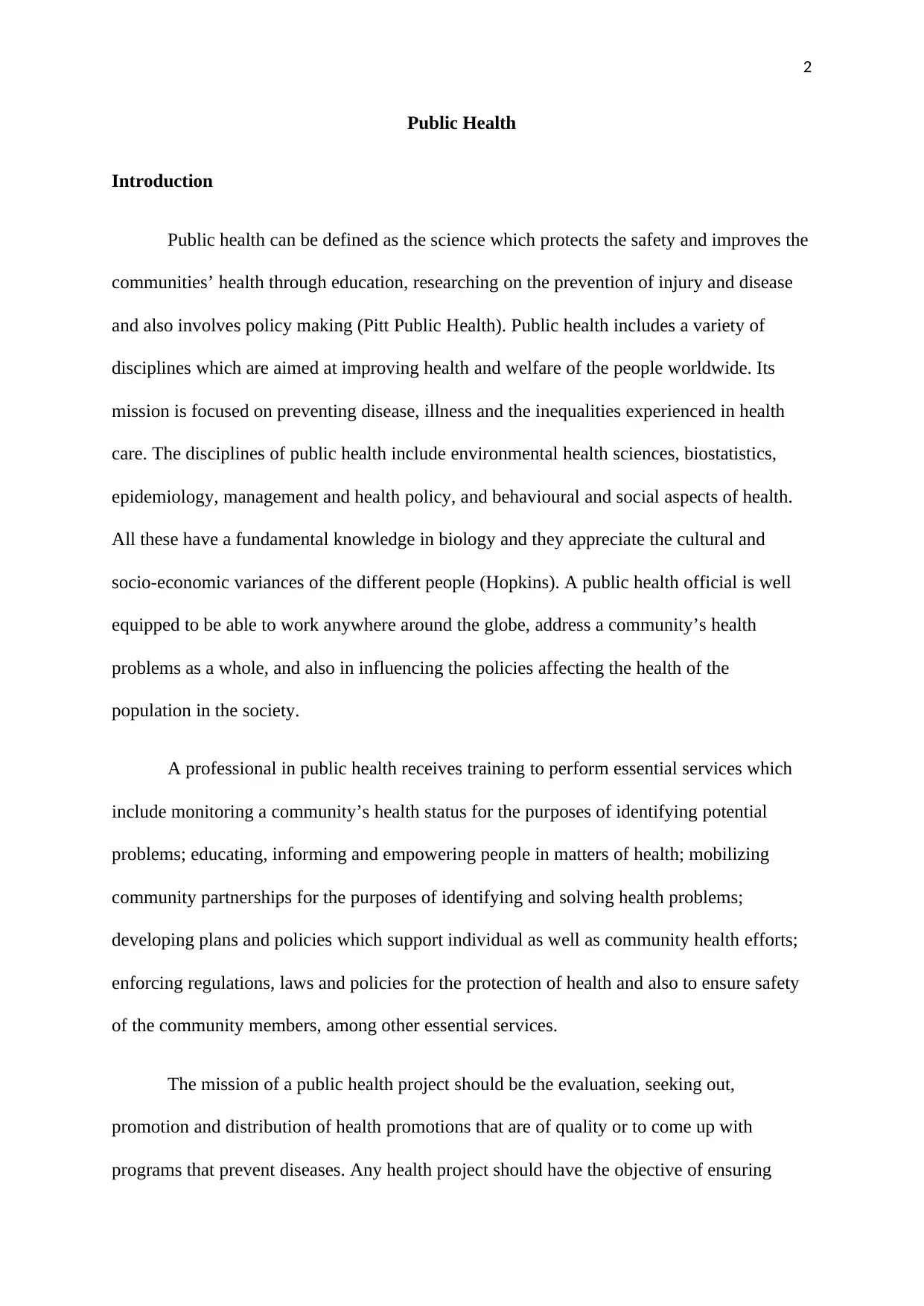
2
Public Health
Introduction
Public health can be defined as the science which protects the safety and improves the
communities’ health through education, researching on the prevention of injury and disease
and also involves policy making (Pitt Public Health). Public health includes a variety of
disciplines which are aimed at improving health and welfare of the people worldwide. Its
mission is focused on preventing disease, illness and the inequalities experienced in health
care. The disciplines of public health include environmental health sciences, biostatistics,
epidemiology, management and health policy, and behavioural and social aspects of health.
All these have a fundamental knowledge in biology and they appreciate the cultural and
socio-economic variances of the different people (Hopkins). A public health official is well
equipped to be able to work anywhere around the globe, address a community’s health
problems as a whole, and also in influencing the policies affecting the health of the
population in the society.
A professional in public health receives training to perform essential services which
include monitoring a community’s health status for the purposes of identifying potential
problems; educating, informing and empowering people in matters of health; mobilizing
community partnerships for the purposes of identifying and solving health problems;
developing plans and policies which support individual as well as community health efforts;
enforcing regulations, laws and policies for the protection of health and also to ensure safety
of the community members, among other essential services.
The mission of a public health project should be the evaluation, seeking out,
promotion and distribution of health promotions that are of quality or to come up with
programs that prevent diseases. Any health project should have the objective of ensuring
Public Health
Introduction
Public health can be defined as the science which protects the safety and improves the
communities’ health through education, researching on the prevention of injury and disease
and also involves policy making (Pitt Public Health). Public health includes a variety of
disciplines which are aimed at improving health and welfare of the people worldwide. Its
mission is focused on preventing disease, illness and the inequalities experienced in health
care. The disciplines of public health include environmental health sciences, biostatistics,
epidemiology, management and health policy, and behavioural and social aspects of health.
All these have a fundamental knowledge in biology and they appreciate the cultural and
socio-economic variances of the different people (Hopkins). A public health official is well
equipped to be able to work anywhere around the globe, address a community’s health
problems as a whole, and also in influencing the policies affecting the health of the
population in the society.
A professional in public health receives training to perform essential services which
include monitoring a community’s health status for the purposes of identifying potential
problems; educating, informing and empowering people in matters of health; mobilizing
community partnerships for the purposes of identifying and solving health problems;
developing plans and policies which support individual as well as community health efforts;
enforcing regulations, laws and policies for the protection of health and also to ensure safety
of the community members, among other essential services.
The mission of a public health project should be the evaluation, seeking out,
promotion and distribution of health promotions that are of quality or to come up with
programs that prevent diseases. Any health project should have the objective of ensuring
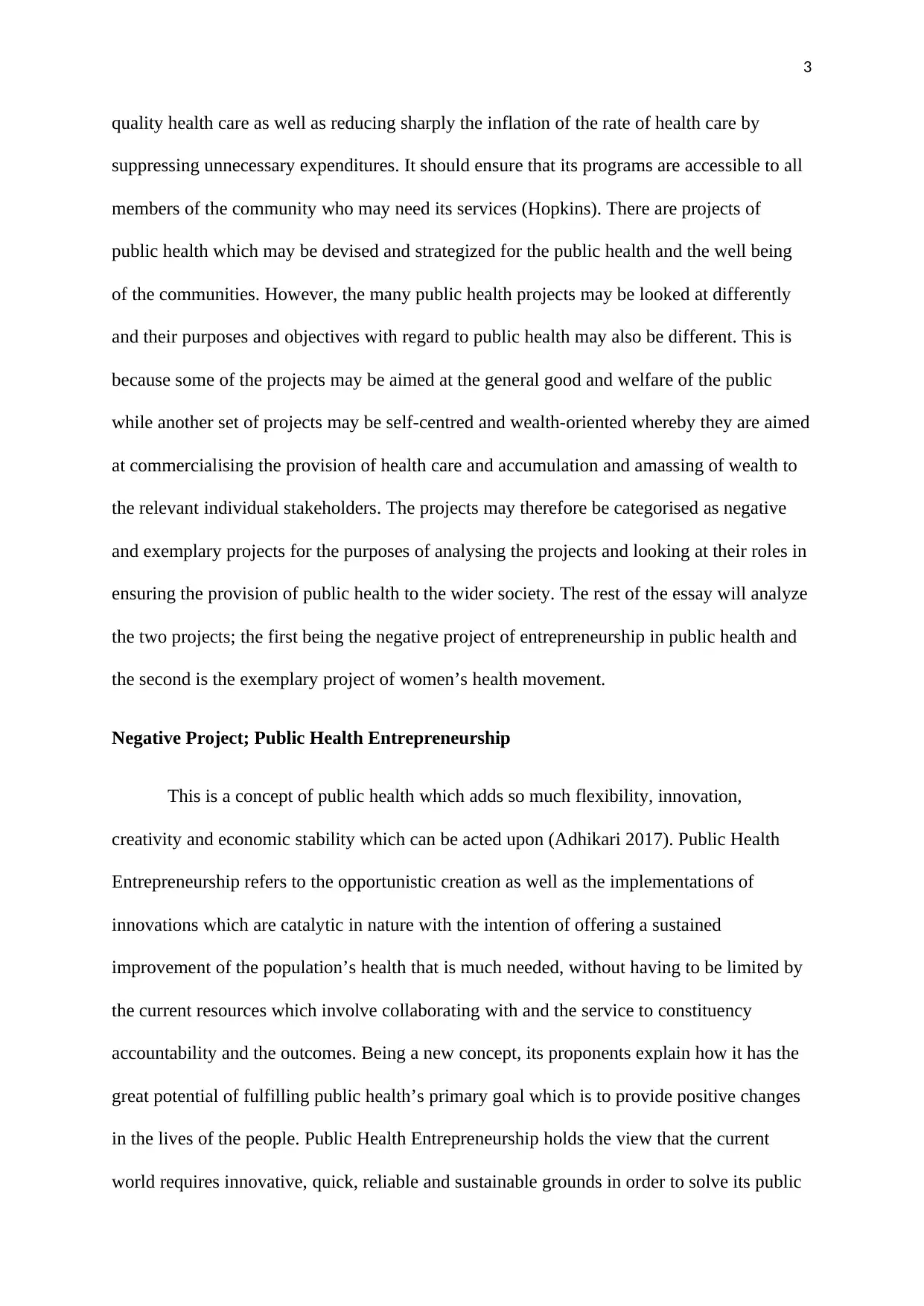
3
quality health care as well as reducing sharply the inflation of the rate of health care by
suppressing unnecessary expenditures. It should ensure that its programs are accessible to all
members of the community who may need its services (Hopkins). There are projects of
public health which may be devised and strategized for the public health and the well being
of the communities. However, the many public health projects may be looked at differently
and their purposes and objectives with regard to public health may also be different. This is
because some of the projects may be aimed at the general good and welfare of the public
while another set of projects may be self-centred and wealth-oriented whereby they are aimed
at commercialising the provision of health care and accumulation and amassing of wealth to
the relevant individual stakeholders. The projects may therefore be categorised as negative
and exemplary projects for the purposes of analysing the projects and looking at their roles in
ensuring the provision of public health to the wider society. The rest of the essay will analyze
the two projects; the first being the negative project of entrepreneurship in public health and
the second is the exemplary project of women’s health movement.
Negative Project; Public Health Entrepreneurship
This is a concept of public health which adds so much flexibility, innovation,
creativity and economic stability which can be acted upon (Adhikari 2017). Public Health
Entrepreneurship refers to the opportunistic creation as well as the implementations of
innovations which are catalytic in nature with the intention of offering a sustained
improvement of the population’s health that is much needed, without having to be limited by
the current resources which involve collaborating with and the service to constituency
accountability and the outcomes. Being a new concept, its proponents explain how it has the
great potential of fulfilling public health’s primary goal which is to provide positive changes
in the lives of the people. Public Health Entrepreneurship holds the view that the current
world requires innovative, quick, reliable and sustainable grounds in order to solve its public
quality health care as well as reducing sharply the inflation of the rate of health care by
suppressing unnecessary expenditures. It should ensure that its programs are accessible to all
members of the community who may need its services (Hopkins). There are projects of
public health which may be devised and strategized for the public health and the well being
of the communities. However, the many public health projects may be looked at differently
and their purposes and objectives with regard to public health may also be different. This is
because some of the projects may be aimed at the general good and welfare of the public
while another set of projects may be self-centred and wealth-oriented whereby they are aimed
at commercialising the provision of health care and accumulation and amassing of wealth to
the relevant individual stakeholders. The projects may therefore be categorised as negative
and exemplary projects for the purposes of analysing the projects and looking at their roles in
ensuring the provision of public health to the wider society. The rest of the essay will analyze
the two projects; the first being the negative project of entrepreneurship in public health and
the second is the exemplary project of women’s health movement.
Negative Project; Public Health Entrepreneurship
This is a concept of public health which adds so much flexibility, innovation,
creativity and economic stability which can be acted upon (Adhikari 2017). Public Health
Entrepreneurship refers to the opportunistic creation as well as the implementations of
innovations which are catalytic in nature with the intention of offering a sustained
improvement of the population’s health that is much needed, without having to be limited by
the current resources which involve collaborating with and the service to constituency
accountability and the outcomes. Being a new concept, its proponents explain how it has the
great potential of fulfilling public health’s primary goal which is to provide positive changes
in the lives of the people. Public Health Entrepreneurship holds the view that the current
world requires innovative, quick, reliable and sustainable grounds in order to solve its public
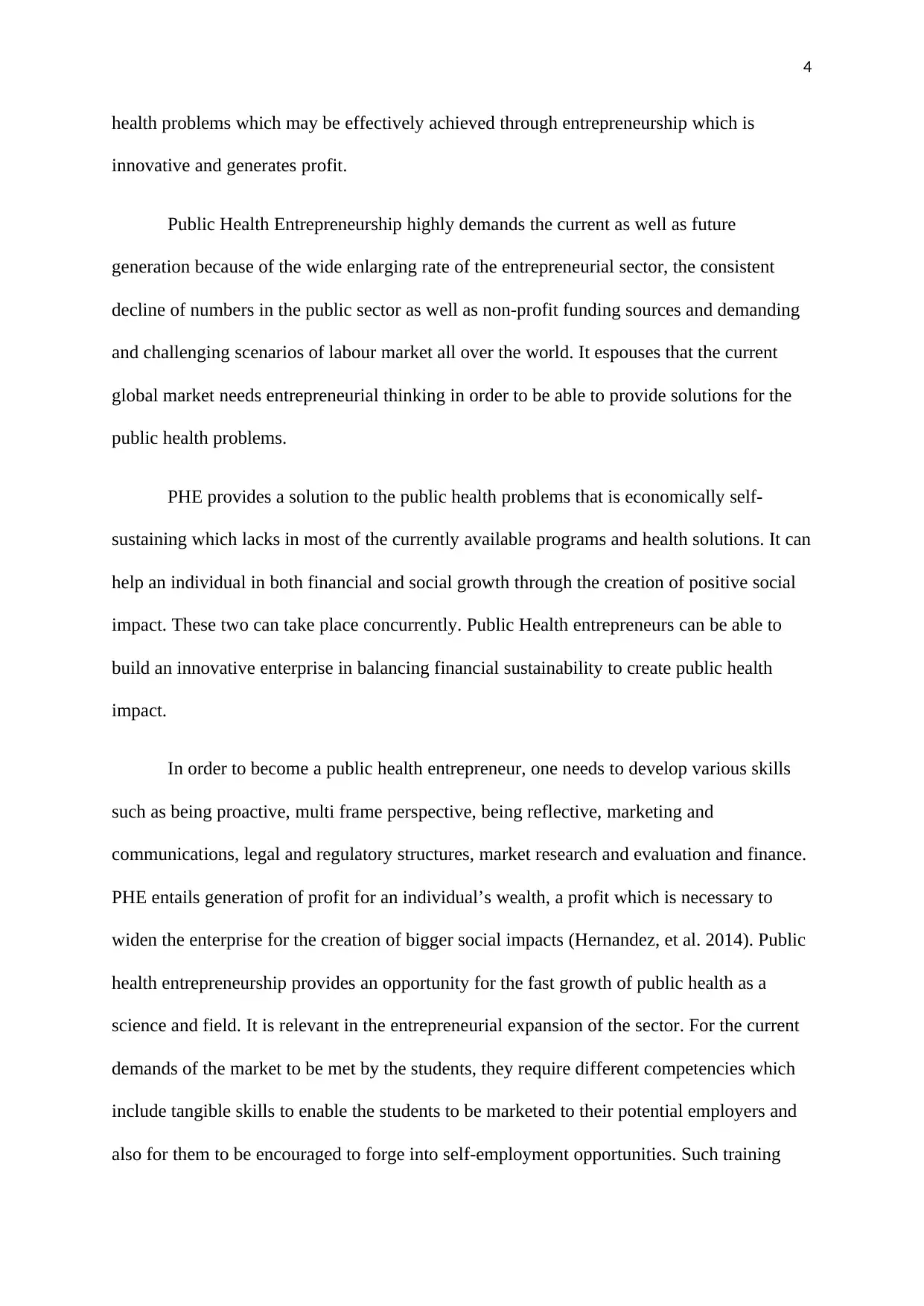
4
health problems which may be effectively achieved through entrepreneurship which is
innovative and generates profit.
Public Health Entrepreneurship highly demands the current as well as future
generation because of the wide enlarging rate of the entrepreneurial sector, the consistent
decline of numbers in the public sector as well as non-profit funding sources and demanding
and challenging scenarios of labour market all over the world. It espouses that the current
global market needs entrepreneurial thinking in order to be able to provide solutions for the
public health problems.
PHE provides a solution to the public health problems that is economically self-
sustaining which lacks in most of the currently available programs and health solutions. It can
help an individual in both financial and social growth through the creation of positive social
impact. These two can take place concurrently. Public Health entrepreneurs can be able to
build an innovative enterprise in balancing financial sustainability to create public health
impact.
In order to become a public health entrepreneur, one needs to develop various skills
such as being proactive, multi frame perspective, being reflective, marketing and
communications, legal and regulatory structures, market research and evaluation and finance.
PHE entails generation of profit for an individual’s wealth, a profit which is necessary to
widen the enterprise for the creation of bigger social impacts (Hernandez, et al. 2014). Public
health entrepreneurship provides an opportunity for the fast growth of public health as a
science and field. It is relevant in the entrepreneurial expansion of the sector. For the current
demands of the market to be met by the students, they require different competencies which
include tangible skills to enable the students to be marketed to their potential employers and
also for them to be encouraged to forge into self-employment opportunities. Such training
health problems which may be effectively achieved through entrepreneurship which is
innovative and generates profit.
Public Health Entrepreneurship highly demands the current as well as future
generation because of the wide enlarging rate of the entrepreneurial sector, the consistent
decline of numbers in the public sector as well as non-profit funding sources and demanding
and challenging scenarios of labour market all over the world. It espouses that the current
global market needs entrepreneurial thinking in order to be able to provide solutions for the
public health problems.
PHE provides a solution to the public health problems that is economically self-
sustaining which lacks in most of the currently available programs and health solutions. It can
help an individual in both financial and social growth through the creation of positive social
impact. These two can take place concurrently. Public Health entrepreneurs can be able to
build an innovative enterprise in balancing financial sustainability to create public health
impact.
In order to become a public health entrepreneur, one needs to develop various skills
such as being proactive, multi frame perspective, being reflective, marketing and
communications, legal and regulatory structures, market research and evaluation and finance.
PHE entails generation of profit for an individual’s wealth, a profit which is necessary to
widen the enterprise for the creation of bigger social impacts (Hernandez, et al. 2014). Public
health entrepreneurship provides an opportunity for the fast growth of public health as a
science and field. It is relevant in the entrepreneurial expansion of the sector. For the current
demands of the market to be met by the students, they require different competencies which
include tangible skills to enable the students to be marketed to their potential employers and
also for them to be encouraged to forge into self-employment opportunities. Such training
Secure Best Marks with AI Grader
Need help grading? Try our AI Grader for instant feedback on your assignments.
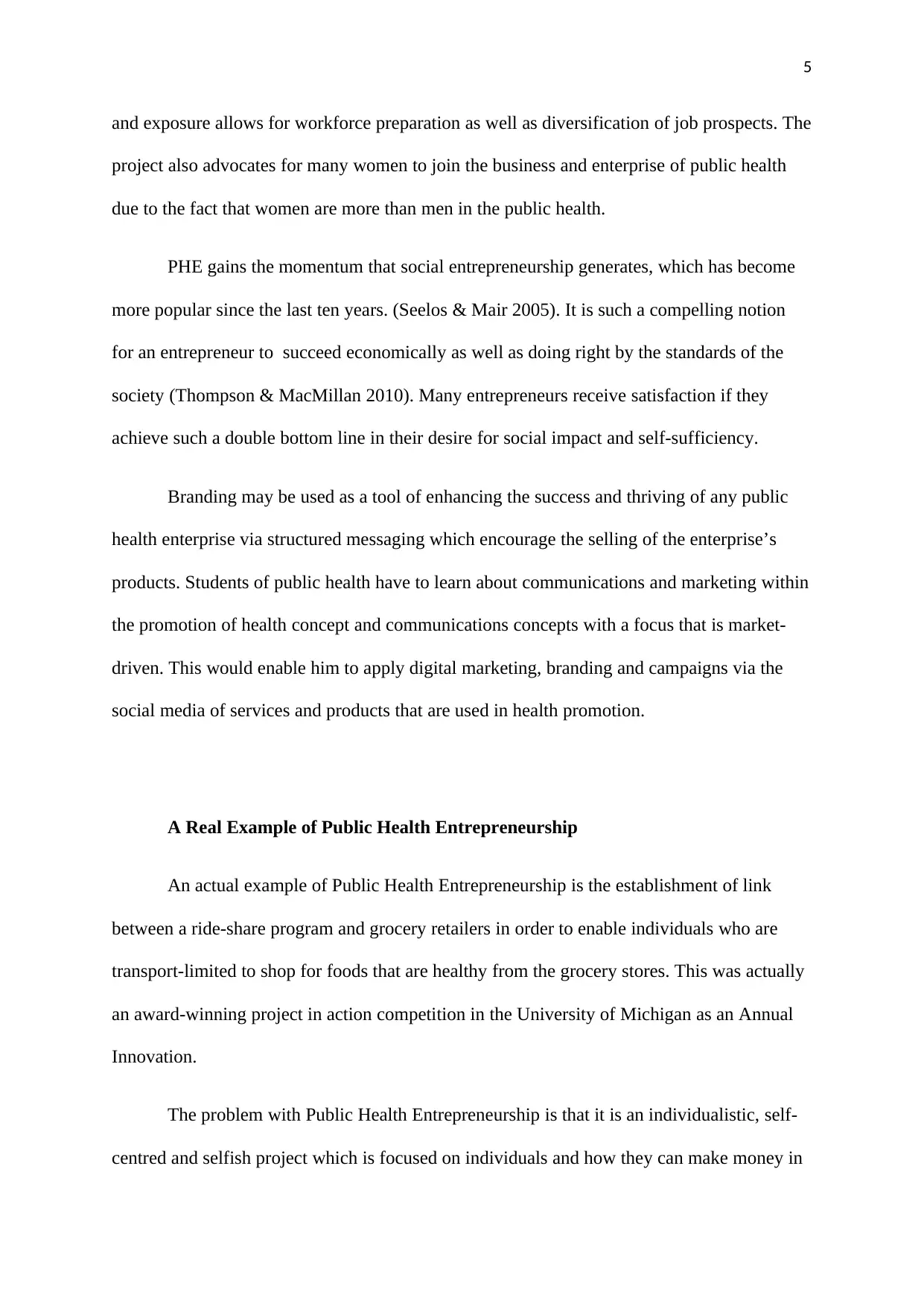
5
and exposure allows for workforce preparation as well as diversification of job prospects. The
project also advocates for many women to join the business and enterprise of public health
due to the fact that women are more than men in the public health.
PHE gains the momentum that social entrepreneurship generates, which has become
more popular since the last ten years. (Seelos & Mair 2005). It is such a compelling notion
for an entrepreneur to succeed economically as well as doing right by the standards of the
society (Thompson & MacMillan 2010). Many entrepreneurs receive satisfaction if they
achieve such a double bottom line in their desire for social impact and self-sufficiency.
Branding may be used as a tool of enhancing the success and thriving of any public
health enterprise via structured messaging which encourage the selling of the enterprise’s
products. Students of public health have to learn about communications and marketing within
the promotion of health concept and communications concepts with a focus that is market-
driven. This would enable him to apply digital marketing, branding and campaigns via the
social media of services and products that are used in health promotion.
A Real Example of Public Health Entrepreneurship
An actual example of Public Health Entrepreneurship is the establishment of link
between a ride-share program and grocery retailers in order to enable individuals who are
transport-limited to shop for foods that are healthy from the grocery stores. This was actually
an award-winning project in action competition in the University of Michigan as an Annual
Innovation.
The problem with Public Health Entrepreneurship is that it is an individualistic, self-
centred and selfish project which is focused on individuals and how they can make money in
and exposure allows for workforce preparation as well as diversification of job prospects. The
project also advocates for many women to join the business and enterprise of public health
due to the fact that women are more than men in the public health.
PHE gains the momentum that social entrepreneurship generates, which has become
more popular since the last ten years. (Seelos & Mair 2005). It is such a compelling notion
for an entrepreneur to succeed economically as well as doing right by the standards of the
society (Thompson & MacMillan 2010). Many entrepreneurs receive satisfaction if they
achieve such a double bottom line in their desire for social impact and self-sufficiency.
Branding may be used as a tool of enhancing the success and thriving of any public
health enterprise via structured messaging which encourage the selling of the enterprise’s
products. Students of public health have to learn about communications and marketing within
the promotion of health concept and communications concepts with a focus that is market-
driven. This would enable him to apply digital marketing, branding and campaigns via the
social media of services and products that are used in health promotion.
A Real Example of Public Health Entrepreneurship
An actual example of Public Health Entrepreneurship is the establishment of link
between a ride-share program and grocery retailers in order to enable individuals who are
transport-limited to shop for foods that are healthy from the grocery stores. This was actually
an award-winning project in action competition in the University of Michigan as an Annual
Innovation.
The problem with Public Health Entrepreneurship is that it is an individualistic, self-
centred and selfish project which is focused on individuals and how they can make money in
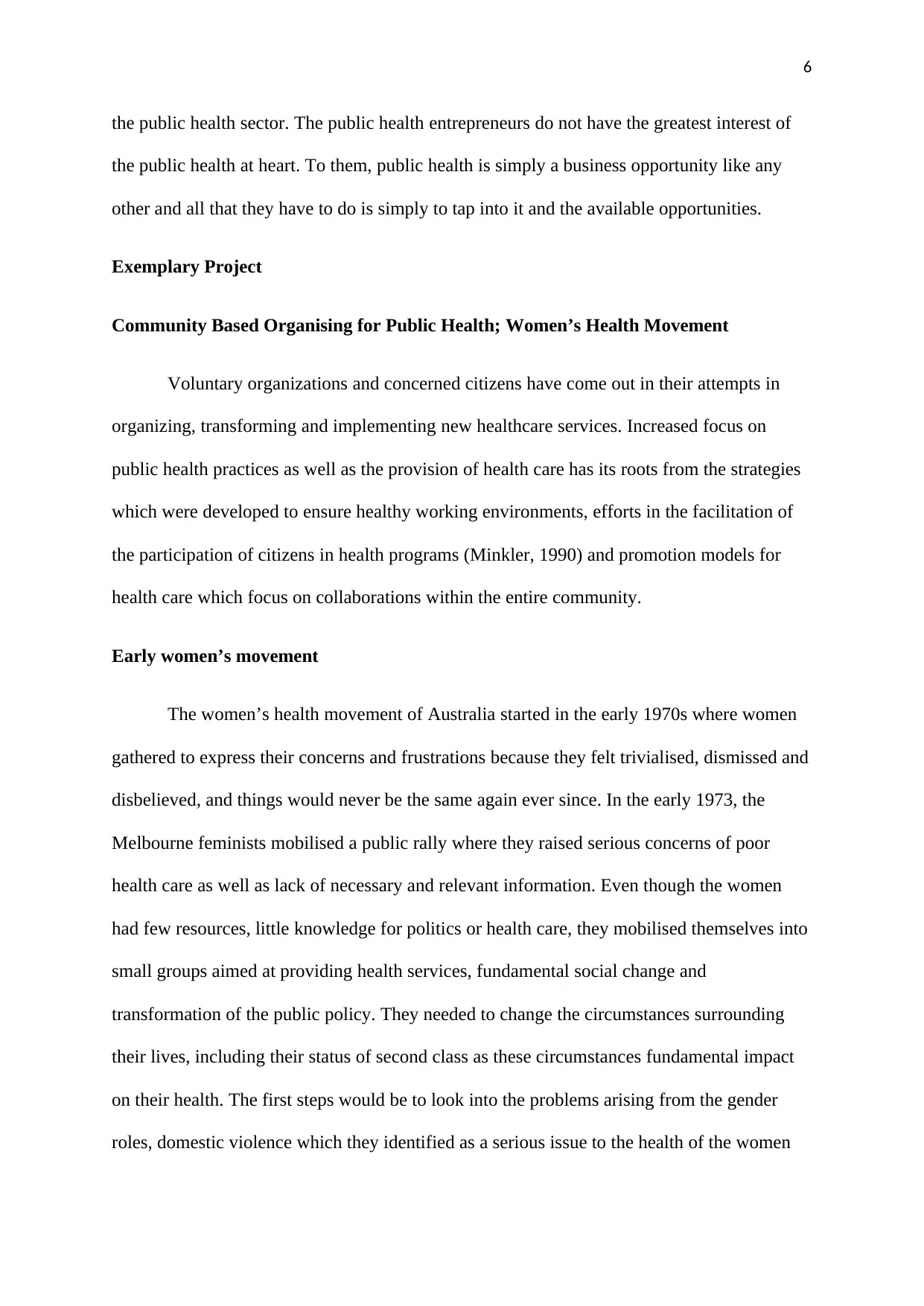
6
the public health sector. The public health entrepreneurs do not have the greatest interest of
the public health at heart. To them, public health is simply a business opportunity like any
other and all that they have to do is simply to tap into it and the available opportunities.
Exemplary Project
Community Based Organising for Public Health; Women’s Health Movement
Voluntary organizations and concerned citizens have come out in their attempts in
organizing, transforming and implementing new healthcare services. Increased focus on
public health practices as well as the provision of health care has its roots from the strategies
which were developed to ensure healthy working environments, efforts in the facilitation of
the participation of citizens in health programs (Minkler, 1990) and promotion models for
health care which focus on collaborations within the entire community.
Early women’s movement
The women’s health movement of Australia started in the early 1970s where women
gathered to express their concerns and frustrations because they felt trivialised, dismissed and
disbelieved, and things would never be the same again ever since. In the early 1973, the
Melbourne feminists mobilised a public rally where they raised serious concerns of poor
health care as well as lack of necessary and relevant information. Even though the women
had few resources, little knowledge for politics or health care, they mobilised themselves into
small groups aimed at providing health services, fundamental social change and
transformation of the public policy. They needed to change the circumstances surrounding
their lives, including their status of second class as these circumstances fundamental impact
on their health. The first steps would be to look into the problems arising from the gender
roles, domestic violence which they identified as a serious issue to the health of the women
the public health sector. The public health entrepreneurs do not have the greatest interest of
the public health at heart. To them, public health is simply a business opportunity like any
other and all that they have to do is simply to tap into it and the available opportunities.
Exemplary Project
Community Based Organising for Public Health; Women’s Health Movement
Voluntary organizations and concerned citizens have come out in their attempts in
organizing, transforming and implementing new healthcare services. Increased focus on
public health practices as well as the provision of health care has its roots from the strategies
which were developed to ensure healthy working environments, efforts in the facilitation of
the participation of citizens in health programs (Minkler, 1990) and promotion models for
health care which focus on collaborations within the entire community.
Early women’s movement
The women’s health movement of Australia started in the early 1970s where women
gathered to express their concerns and frustrations because they felt trivialised, dismissed and
disbelieved, and things would never be the same again ever since. In the early 1973, the
Melbourne feminists mobilised a public rally where they raised serious concerns of poor
health care as well as lack of necessary and relevant information. Even though the women
had few resources, little knowledge for politics or health care, they mobilised themselves into
small groups aimed at providing health services, fundamental social change and
transformation of the public policy. They needed to change the circumstances surrounding
their lives, including their status of second class as these circumstances fundamental impact
on their health. The first steps would be to look into the problems arising from the gender
roles, domestic violence which they identified as a serious issue to the health of the women
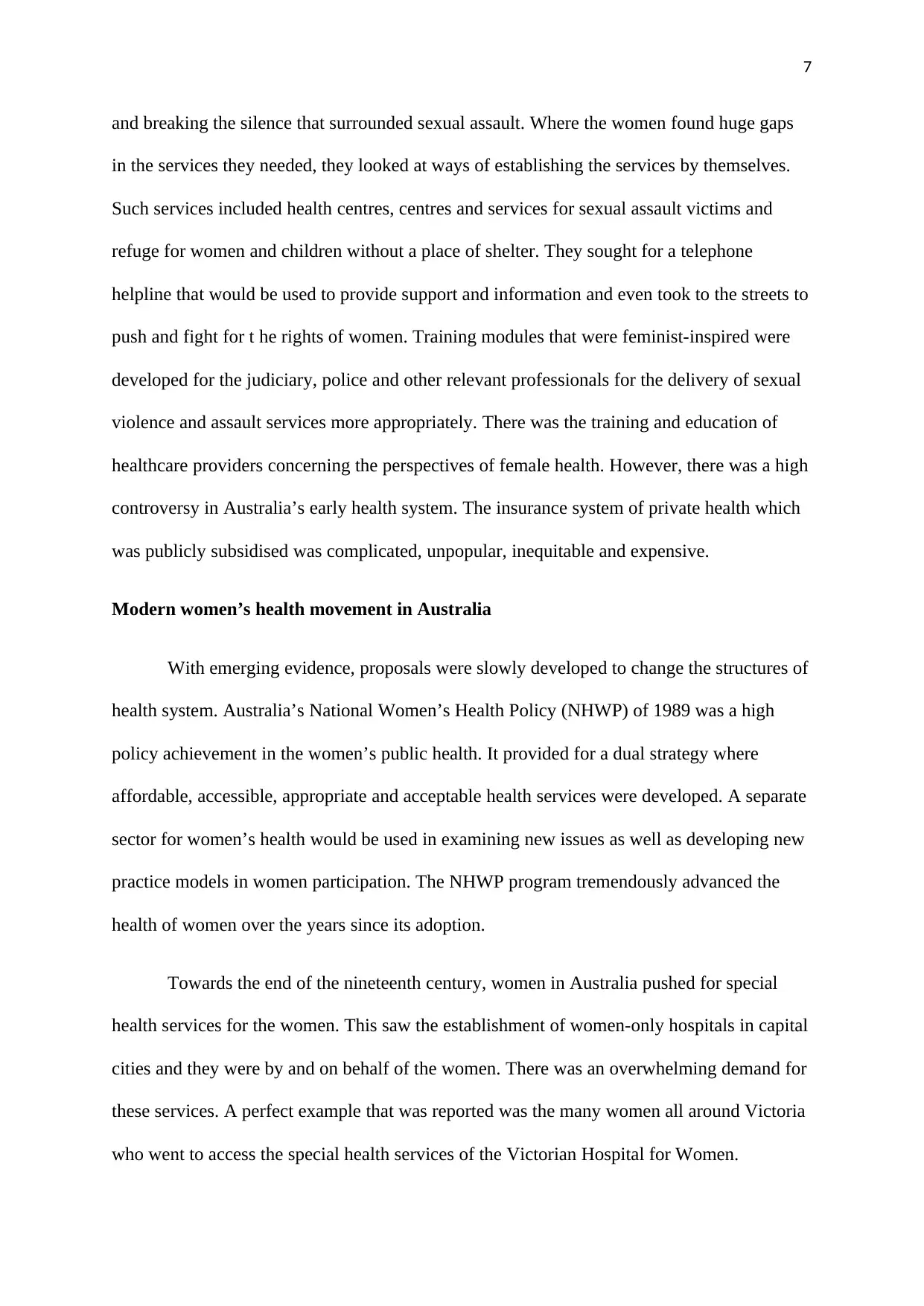
7
and breaking the silence that surrounded sexual assault. Where the women found huge gaps
in the services they needed, they looked at ways of establishing the services by themselves.
Such services included health centres, centres and services for sexual assault victims and
refuge for women and children without a place of shelter. They sought for a telephone
helpline that would be used to provide support and information and even took to the streets to
push and fight for t he rights of women. Training modules that were feminist-inspired were
developed for the judiciary, police and other relevant professionals for the delivery of sexual
violence and assault services more appropriately. There was the training and education of
healthcare providers concerning the perspectives of female health. However, there was a high
controversy in Australia’s early health system. The insurance system of private health which
was publicly subsidised was complicated, unpopular, inequitable and expensive.
Modern women’s health movement in Australia
With emerging evidence, proposals were slowly developed to change the structures of
health system. Australia’s National Women’s Health Policy (NHWP) of 1989 was a high
policy achievement in the women’s public health. It provided for a dual strategy where
affordable, accessible, appropriate and acceptable health services were developed. A separate
sector for women’s health would be used in examining new issues as well as developing new
practice models in women participation. The NHWP program tremendously advanced the
health of women over the years since its adoption.
Towards the end of the nineteenth century, women in Australia pushed for special
health services for the women. This saw the establishment of women-only hospitals in capital
cities and they were by and on behalf of the women. There was an overwhelming demand for
these services. A perfect example that was reported was the many women all around Victoria
who went to access the special health services of the Victorian Hospital for Women.
and breaking the silence that surrounded sexual assault. Where the women found huge gaps
in the services they needed, they looked at ways of establishing the services by themselves.
Such services included health centres, centres and services for sexual assault victims and
refuge for women and children without a place of shelter. They sought for a telephone
helpline that would be used to provide support and information and even took to the streets to
push and fight for t he rights of women. Training modules that were feminist-inspired were
developed for the judiciary, police and other relevant professionals for the delivery of sexual
violence and assault services more appropriately. There was the training and education of
healthcare providers concerning the perspectives of female health. However, there was a high
controversy in Australia’s early health system. The insurance system of private health which
was publicly subsidised was complicated, unpopular, inequitable and expensive.
Modern women’s health movement in Australia
With emerging evidence, proposals were slowly developed to change the structures of
health system. Australia’s National Women’s Health Policy (NHWP) of 1989 was a high
policy achievement in the women’s public health. It provided for a dual strategy where
affordable, accessible, appropriate and acceptable health services were developed. A separate
sector for women’s health would be used in examining new issues as well as developing new
practice models in women participation. The NHWP program tremendously advanced the
health of women over the years since its adoption.
Towards the end of the nineteenth century, women in Australia pushed for special
health services for the women. This saw the establishment of women-only hospitals in capital
cities and they were by and on behalf of the women. There was an overwhelming demand for
these services. A perfect example that was reported was the many women all around Victoria
who went to access the special health services of the Victorian Hospital for Women.
Paraphrase This Document
Need a fresh take? Get an instant paraphrase of this document with our AI Paraphraser
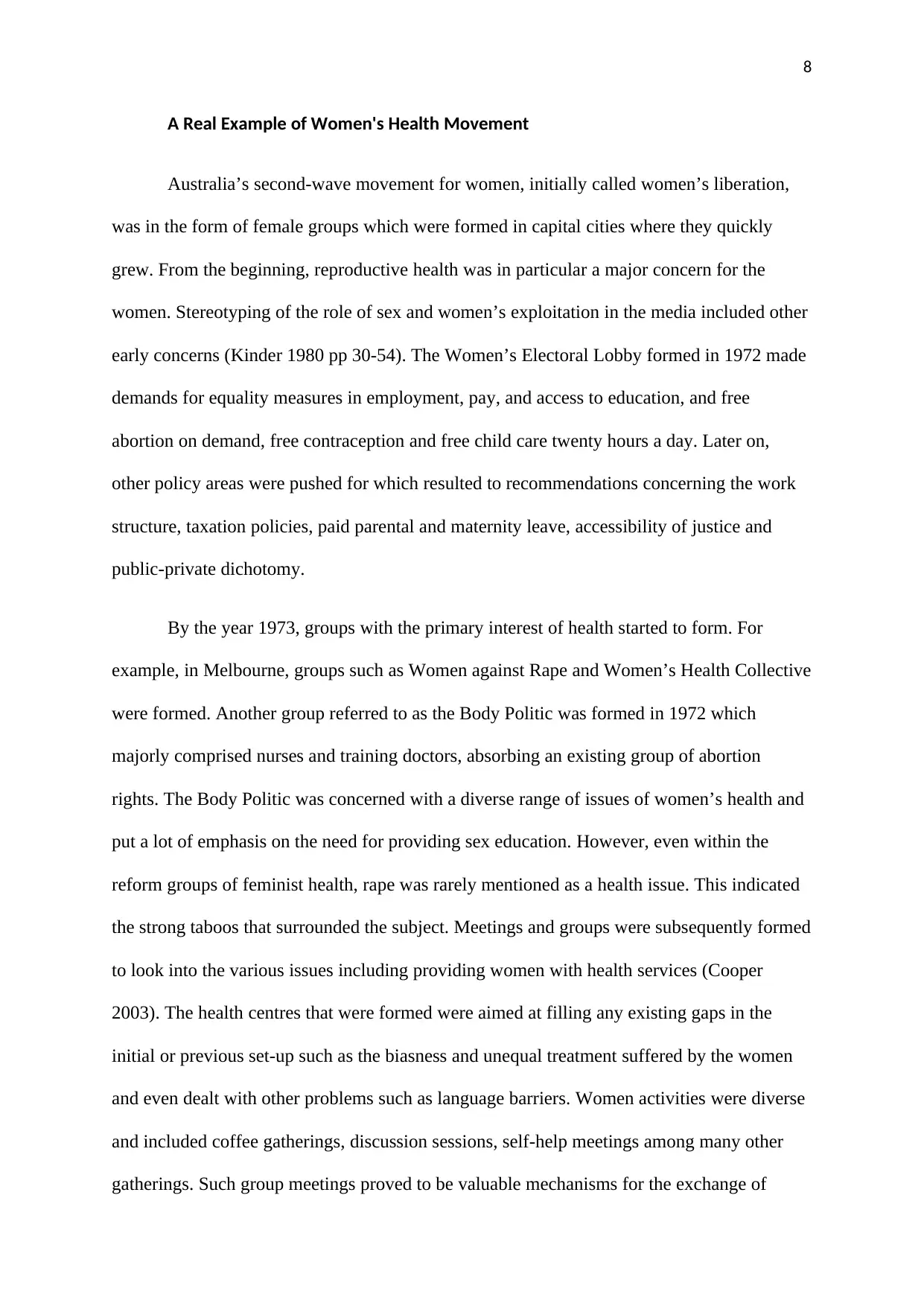
8
A Real Example of Women's Health Movement
Australia’s second-wave movement for women, initially called women’s liberation,
was in the form of female groups which were formed in capital cities where they quickly
grew. From the beginning, reproductive health was in particular a major concern for the
women. Stereotyping of the role of sex and women’s exploitation in the media included other
early concerns (Kinder 1980 pp 30-54). The Women’s Electoral Lobby formed in 1972 made
demands for equality measures in employment, pay, and access to education, and free
abortion on demand, free contraception and free child care twenty hours a day. Later on,
other policy areas were pushed for which resulted to recommendations concerning the work
structure, taxation policies, paid parental and maternity leave, accessibility of justice and
public-private dichotomy.
By the year 1973, groups with the primary interest of health started to form. For
example, in Melbourne, groups such as Women against Rape and Women’s Health Collective
were formed. Another group referred to as the Body Politic was formed in 1972 which
majorly comprised nurses and training doctors, absorbing an existing group of abortion
rights. The Body Politic was concerned with a diverse range of issues of women’s health and
put a lot of emphasis on the need for providing sex education. However, even within the
reform groups of feminist health, rape was rarely mentioned as a health issue. This indicated
the strong taboos that surrounded the subject. Meetings and groups were subsequently formed
to look into the various issues including providing women with health services (Cooper
2003). The health centres that were formed were aimed at filling any existing gaps in the
initial or previous set-up such as the biasness and unequal treatment suffered by the women
and even dealt with other problems such as language barriers. Women activities were diverse
and included coffee gatherings, discussion sessions, self-help meetings among many other
gatherings. Such group meetings proved to be valuable mechanisms for the exchange of
A Real Example of Women's Health Movement
Australia’s second-wave movement for women, initially called women’s liberation,
was in the form of female groups which were formed in capital cities where they quickly
grew. From the beginning, reproductive health was in particular a major concern for the
women. Stereotyping of the role of sex and women’s exploitation in the media included other
early concerns (Kinder 1980 pp 30-54). The Women’s Electoral Lobby formed in 1972 made
demands for equality measures in employment, pay, and access to education, and free
abortion on demand, free contraception and free child care twenty hours a day. Later on,
other policy areas were pushed for which resulted to recommendations concerning the work
structure, taxation policies, paid parental and maternity leave, accessibility of justice and
public-private dichotomy.
By the year 1973, groups with the primary interest of health started to form. For
example, in Melbourne, groups such as Women against Rape and Women’s Health Collective
were formed. Another group referred to as the Body Politic was formed in 1972 which
majorly comprised nurses and training doctors, absorbing an existing group of abortion
rights. The Body Politic was concerned with a diverse range of issues of women’s health and
put a lot of emphasis on the need for providing sex education. However, even within the
reform groups of feminist health, rape was rarely mentioned as a health issue. This indicated
the strong taboos that surrounded the subject. Meetings and groups were subsequently formed
to look into the various issues including providing women with health services (Cooper
2003). The health centres that were formed were aimed at filling any existing gaps in the
initial or previous set-up such as the biasness and unequal treatment suffered by the women
and even dealt with other problems such as language barriers. Women activities were diverse
and included coffee gatherings, discussion sessions, self-help meetings among many other
gatherings. Such group meetings proved to be valuable mechanisms for the exchange of
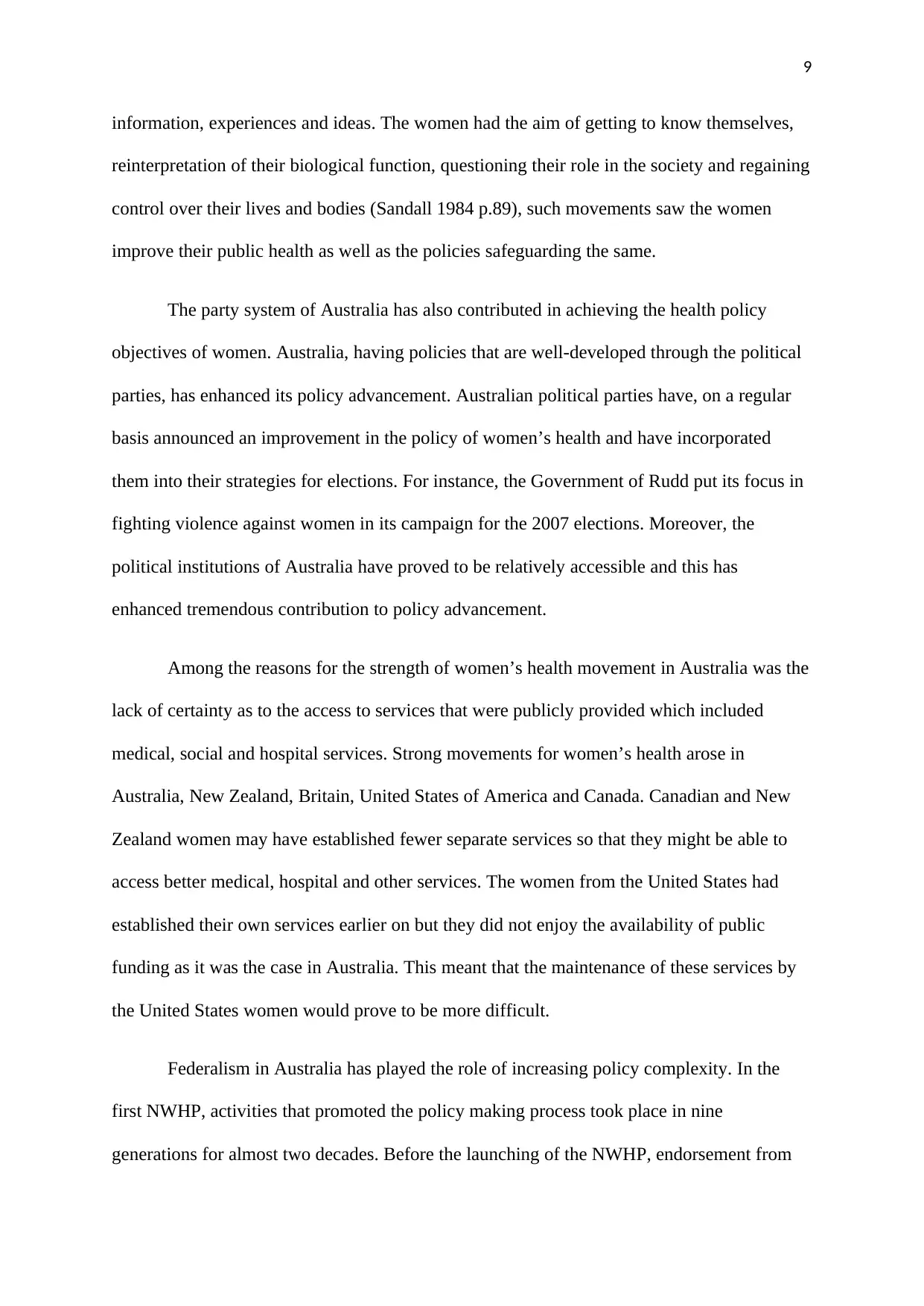
9
information, experiences and ideas. The women had the aim of getting to know themselves,
reinterpretation of their biological function, questioning their role in the society and regaining
control over their lives and bodies (Sandall 1984 p.89), such movements saw the women
improve their public health as well as the policies safeguarding the same.
The party system of Australia has also contributed in achieving the health policy
objectives of women. Australia, having policies that are well-developed through the political
parties, has enhanced its policy advancement. Australian political parties have, on a regular
basis announced an improvement in the policy of women’s health and have incorporated
them into their strategies for elections. For instance, the Government of Rudd put its focus in
fighting violence against women in its campaign for the 2007 elections. Moreover, the
political institutions of Australia have proved to be relatively accessible and this has
enhanced tremendous contribution to policy advancement.
Among the reasons for the strength of women’s health movement in Australia was the
lack of certainty as to the access to services that were publicly provided which included
medical, social and hospital services. Strong movements for women’s health arose in
Australia, New Zealand, Britain, United States of America and Canada. Canadian and New
Zealand women may have established fewer separate services so that they might be able to
access better medical, hospital and other services. The women from the United States had
established their own services earlier on but they did not enjoy the availability of public
funding as it was the case in Australia. This meant that the maintenance of these services by
the United States women would prove to be more difficult.
Federalism in Australia has played the role of increasing policy complexity. In the
first NWHP, activities that promoted the policy making process took place in nine
generations for almost two decades. Before the launching of the NWHP, endorsement from
information, experiences and ideas. The women had the aim of getting to know themselves,
reinterpretation of their biological function, questioning their role in the society and regaining
control over their lives and bodies (Sandall 1984 p.89), such movements saw the women
improve their public health as well as the policies safeguarding the same.
The party system of Australia has also contributed in achieving the health policy
objectives of women. Australia, having policies that are well-developed through the political
parties, has enhanced its policy advancement. Australian political parties have, on a regular
basis announced an improvement in the policy of women’s health and have incorporated
them into their strategies for elections. For instance, the Government of Rudd put its focus in
fighting violence against women in its campaign for the 2007 elections. Moreover, the
political institutions of Australia have proved to be relatively accessible and this has
enhanced tremendous contribution to policy advancement.
Among the reasons for the strength of women’s health movement in Australia was the
lack of certainty as to the access to services that were publicly provided which included
medical, social and hospital services. Strong movements for women’s health arose in
Australia, New Zealand, Britain, United States of America and Canada. Canadian and New
Zealand women may have established fewer separate services so that they might be able to
access better medical, hospital and other services. The women from the United States had
established their own services earlier on but they did not enjoy the availability of public
funding as it was the case in Australia. This meant that the maintenance of these services by
the United States women would prove to be more difficult.
Federalism in Australia has played the role of increasing policy complexity. In the
first NWHP, activities that promoted the policy making process took place in nine
generations for almost two decades. Before the launching of the NWHP, endorsement from
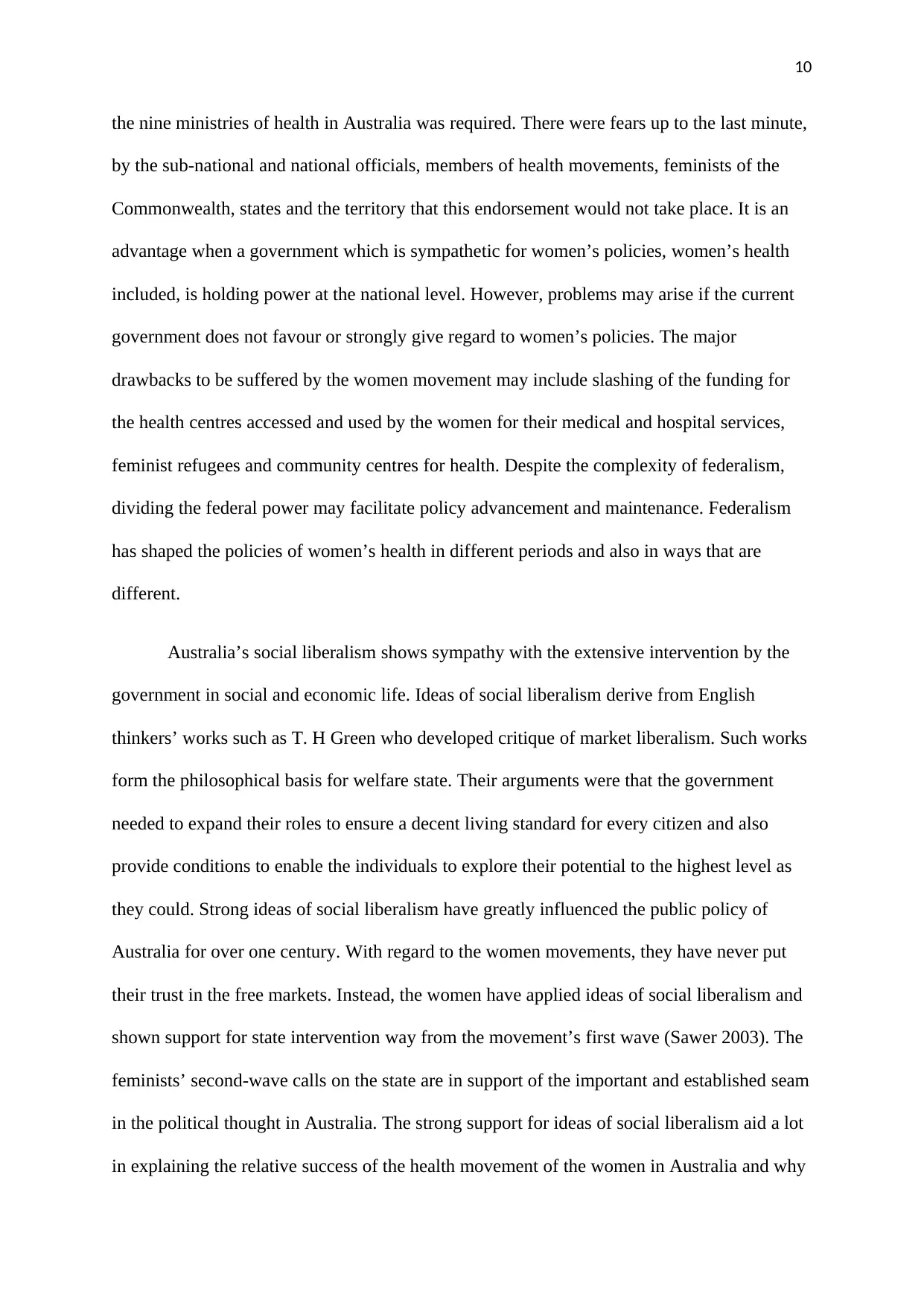
10
the nine ministries of health in Australia was required. There were fears up to the last minute,
by the sub-national and national officials, members of health movements, feminists of the
Commonwealth, states and the territory that this endorsement would not take place. It is an
advantage when a government which is sympathetic for women’s policies, women’s health
included, is holding power at the national level. However, problems may arise if the current
government does not favour or strongly give regard to women’s policies. The major
drawbacks to be suffered by the women movement may include slashing of the funding for
the health centres accessed and used by the women for their medical and hospital services,
feminist refugees and community centres for health. Despite the complexity of federalism,
dividing the federal power may facilitate policy advancement and maintenance. Federalism
has shaped the policies of women’s health in different periods and also in ways that are
different.
Australia’s social liberalism shows sympathy with the extensive intervention by the
government in social and economic life. Ideas of social liberalism derive from English
thinkers’ works such as T. H Green who developed critique of market liberalism. Such works
form the philosophical basis for welfare state. Their arguments were that the government
needed to expand their roles to ensure a decent living standard for every citizen and also
provide conditions to enable the individuals to explore their potential to the highest level as
they could. Strong ideas of social liberalism have greatly influenced the public policy of
Australia for over one century. With regard to the women movements, they have never put
their trust in the free markets. Instead, the women have applied ideas of social liberalism and
shown support for state intervention way from the movement’s first wave (Sawer 2003). The
feminists’ second-wave calls on the state are in support of the important and established seam
in the political thought in Australia. The strong support for ideas of social liberalism aid a lot
in explaining the relative success of the health movement of the women in Australia and why
the nine ministries of health in Australia was required. There were fears up to the last minute,
by the sub-national and national officials, members of health movements, feminists of the
Commonwealth, states and the territory that this endorsement would not take place. It is an
advantage when a government which is sympathetic for women’s policies, women’s health
included, is holding power at the national level. However, problems may arise if the current
government does not favour or strongly give regard to women’s policies. The major
drawbacks to be suffered by the women movement may include slashing of the funding for
the health centres accessed and used by the women for their medical and hospital services,
feminist refugees and community centres for health. Despite the complexity of federalism,
dividing the federal power may facilitate policy advancement and maintenance. Federalism
has shaped the policies of women’s health in different periods and also in ways that are
different.
Australia’s social liberalism shows sympathy with the extensive intervention by the
government in social and economic life. Ideas of social liberalism derive from English
thinkers’ works such as T. H Green who developed critique of market liberalism. Such works
form the philosophical basis for welfare state. Their arguments were that the government
needed to expand their roles to ensure a decent living standard for every citizen and also
provide conditions to enable the individuals to explore their potential to the highest level as
they could. Strong ideas of social liberalism have greatly influenced the public policy of
Australia for over one century. With regard to the women movements, they have never put
their trust in the free markets. Instead, the women have applied ideas of social liberalism and
shown support for state intervention way from the movement’s first wave (Sawer 2003). The
feminists’ second-wave calls on the state are in support of the important and established seam
in the political thought in Australia. The strong support for ideas of social liberalism aid a lot
in explaining the relative success of the health movement of the women in Australia and why
Secure Best Marks with AI Grader
Need help grading? Try our AI Grader for instant feedback on your assignments.
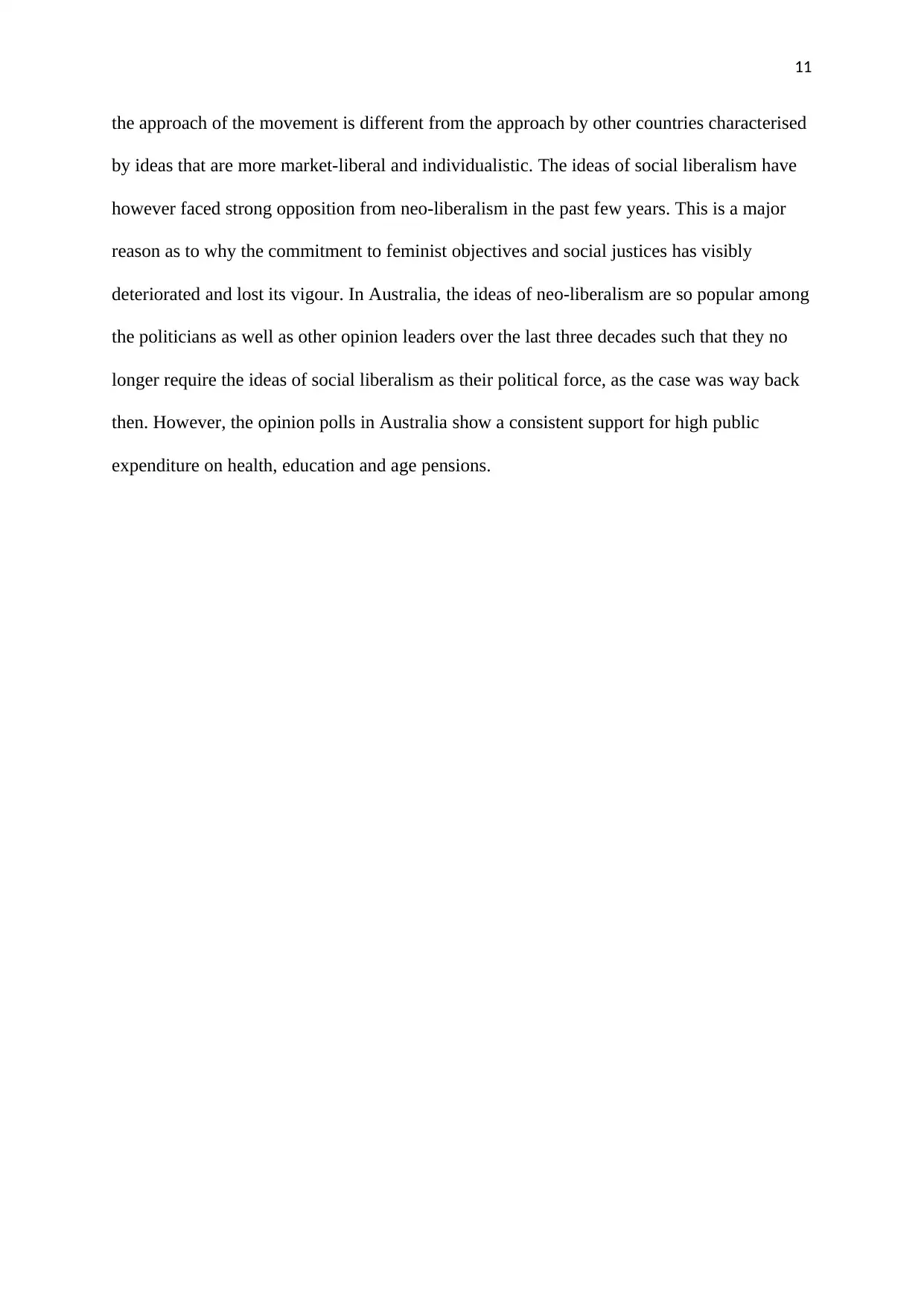
11
the approach of the movement is different from the approach by other countries characterised
by ideas that are more market-liberal and individualistic. The ideas of social liberalism have
however faced strong opposition from neo-liberalism in the past few years. This is a major
reason as to why the commitment to feminist objectives and social justices has visibly
deteriorated and lost its vigour. In Australia, the ideas of neo-liberalism are so popular among
the politicians as well as other opinion leaders over the last three decades such that they no
longer require the ideas of social liberalism as their political force, as the case was way back
then. However, the opinion polls in Australia show a consistent support for high public
expenditure on health, education and age pensions.
the approach of the movement is different from the approach by other countries characterised
by ideas that are more market-liberal and individualistic. The ideas of social liberalism have
however faced strong opposition from neo-liberalism in the past few years. This is a major
reason as to why the commitment to feminist objectives and social justices has visibly
deteriorated and lost its vigour. In Australia, the ideas of neo-liberalism are so popular among
the politicians as well as other opinion leaders over the last three decades such that they no
longer require the ideas of social liberalism as their political force, as the case was way back
then. However, the opinion polls in Australia show a consistent support for high public
expenditure on health, education and age pensions.
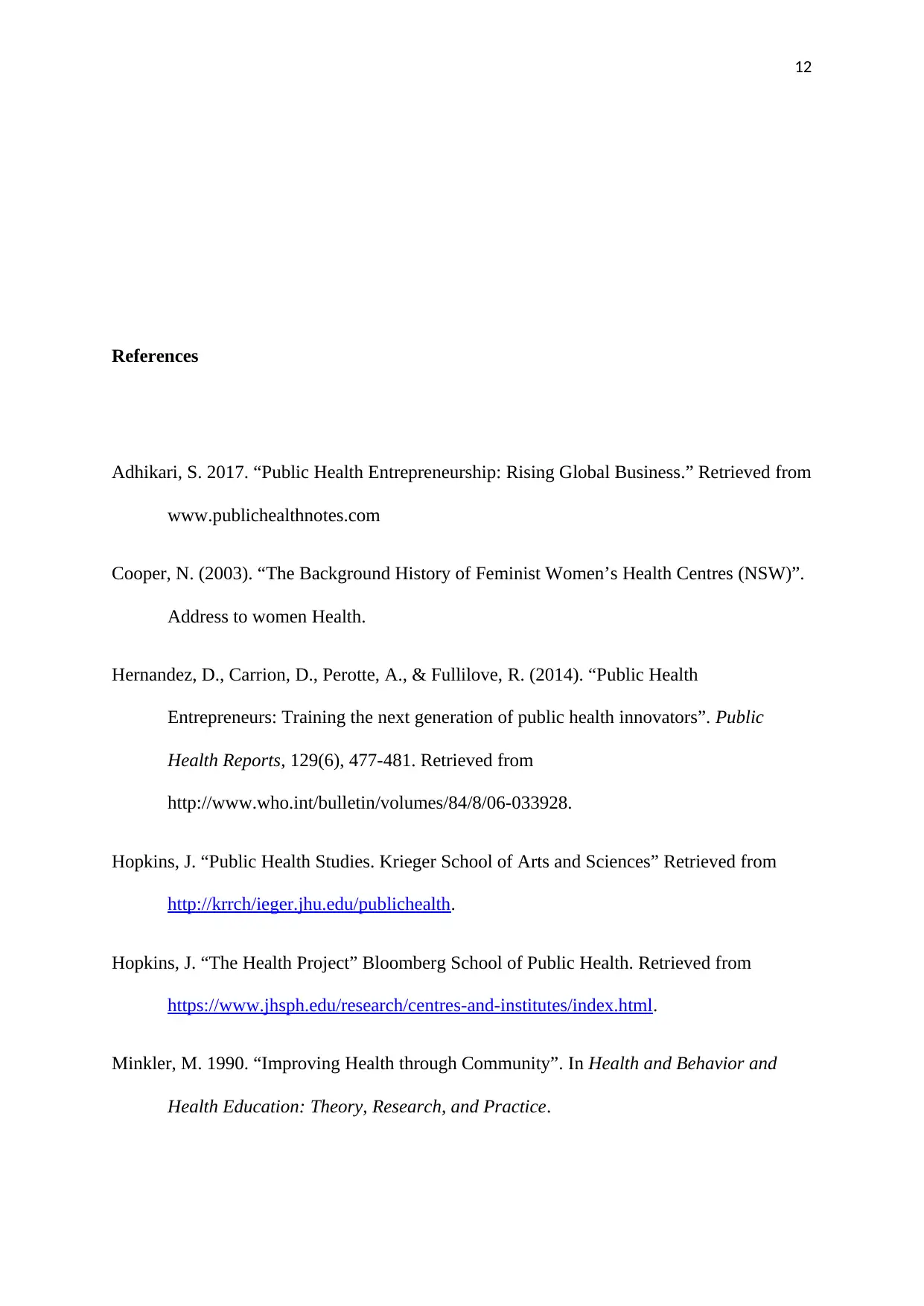
12
References
Adhikari, S. 2017. “Public Health Entrepreneurship: Rising Global Business.” Retrieved from
www.publichealthnotes.com
Cooper, N. (2003). “The Background History of Feminist Women’s Health Centres (NSW)”.
Address to women Health.
Hernandez, D., Carrion, D., Perotte, A., & Fullilove, R. (2014). “Public Health
Entrepreneurs: Training the next generation of public health innovators”. Public
Health Reports, 129(6), 477-481. Retrieved from
http://www.who.int/bulletin/volumes/84/8/06-033928.
Hopkins, J. “Public Health Studies. Krieger School of Arts and Sciences” Retrieved from
http://krrch/ieger.jhu.edu/publichealth.
Hopkins, J. “The Health Project” Bloomberg School of Public Health. Retrieved from
https://www.jhsph.edu/research/centres-and-institutes/index.html.
Minkler, M. 1990. “Improving Health through Community”. In Health and Behavior and
Health Education: Theory, Research, and Practice.
References
Adhikari, S. 2017. “Public Health Entrepreneurship: Rising Global Business.” Retrieved from
www.publichealthnotes.com
Cooper, N. (2003). “The Background History of Feminist Women’s Health Centres (NSW)”.
Address to women Health.
Hernandez, D., Carrion, D., Perotte, A., & Fullilove, R. (2014). “Public Health
Entrepreneurs: Training the next generation of public health innovators”. Public
Health Reports, 129(6), 477-481. Retrieved from
http://www.who.int/bulletin/volumes/84/8/06-033928.
Hopkins, J. “Public Health Studies. Krieger School of Arts and Sciences” Retrieved from
http://krrch/ieger.jhu.edu/publichealth.
Hopkins, J. “The Health Project” Bloomberg School of Public Health. Retrieved from
https://www.jhsph.edu/research/centres-and-institutes/index.html.
Minkler, M. 1990. “Improving Health through Community”. In Health and Behavior and
Health Education: Theory, Research, and Practice.
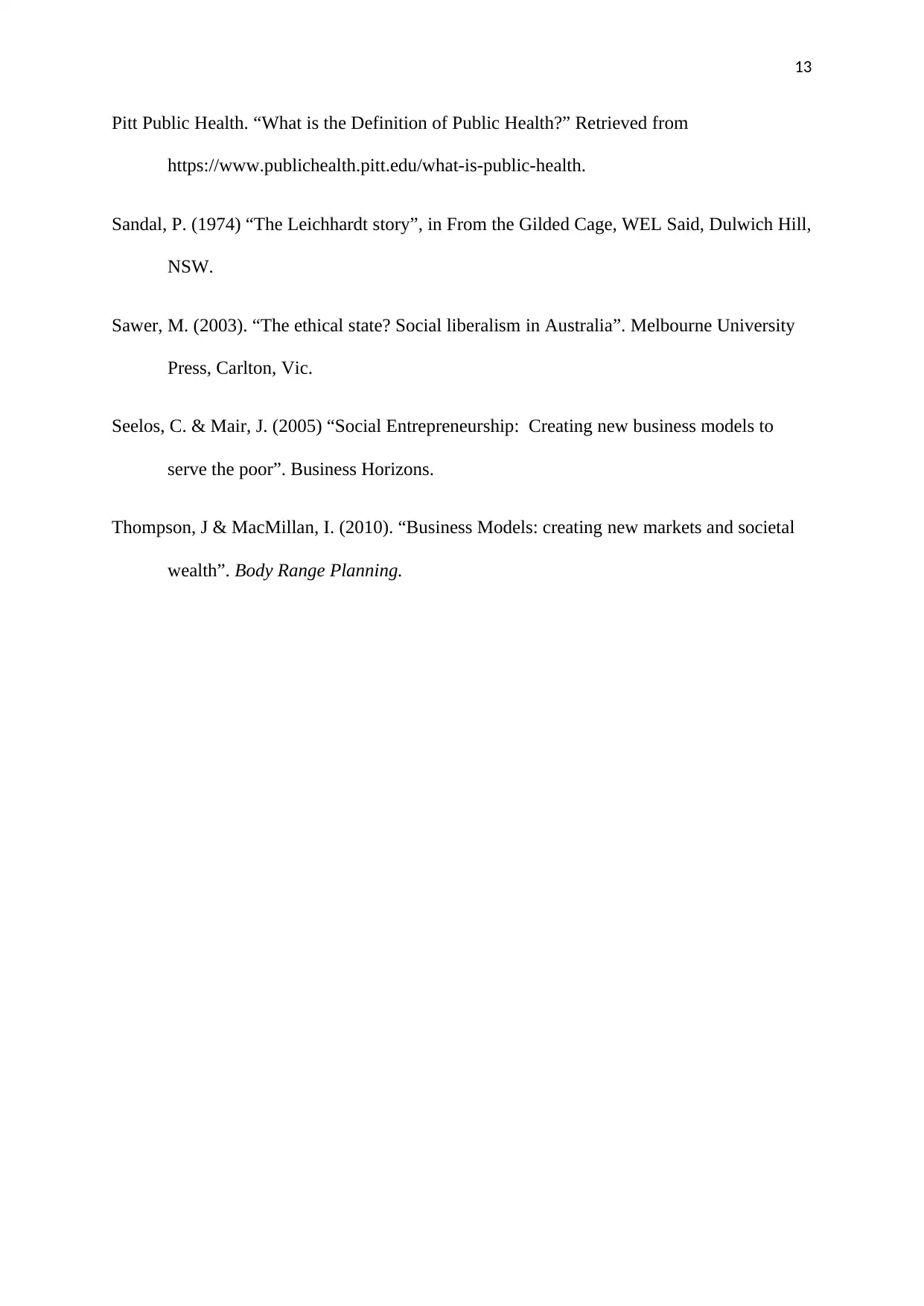
13
Pitt Public Health. “What is the Definition of Public Health?” Retrieved from
https://www.publichealth.pitt.edu/what-is-public-health.
Sandal, P. (1974) “The Leichhardt story”, in From the Gilded Cage, WEL Said, Dulwich Hill,
NSW.
Sawer, M. (2003). “The ethical state? Social liberalism in Australia”. Melbourne University
Press, Carlton, Vic.
Seelos, C. & Mair, J. (2005) “Social Entrepreneurship: Creating new business models to
serve the poor”. Business Horizons.
Thompson, J & MacMillan, I. (2010). “Business Models: creating new markets and societal
wealth”. Body Range Planning.
Pitt Public Health. “What is the Definition of Public Health?” Retrieved from
https://www.publichealth.pitt.edu/what-is-public-health.
Sandal, P. (1974) “The Leichhardt story”, in From the Gilded Cage, WEL Said, Dulwich Hill,
NSW.
Sawer, M. (2003). “The ethical state? Social liberalism in Australia”. Melbourne University
Press, Carlton, Vic.
Seelos, C. & Mair, J. (2005) “Social Entrepreneurship: Creating new business models to
serve the poor”. Business Horizons.
Thompson, J & MacMillan, I. (2010). “Business Models: creating new markets and societal
wealth”. Body Range Planning.
1 out of 13
Related Documents
Your All-in-One AI-Powered Toolkit for Academic Success.
+13062052269
info@desklib.com
Available 24*7 on WhatsApp / Email
![[object Object]](/_next/static/media/star-bottom.7253800d.svg)
Unlock your academic potential
© 2024 | Zucol Services PVT LTD | All rights reserved.





